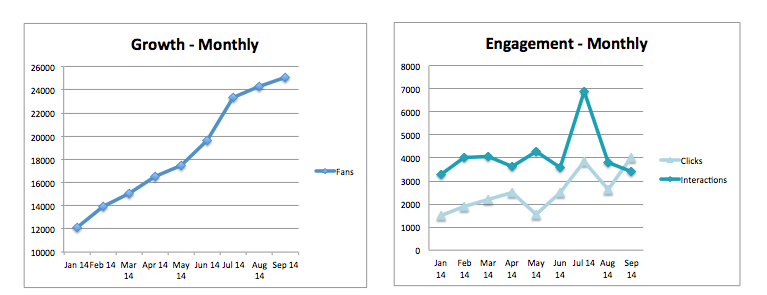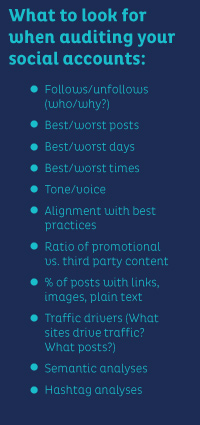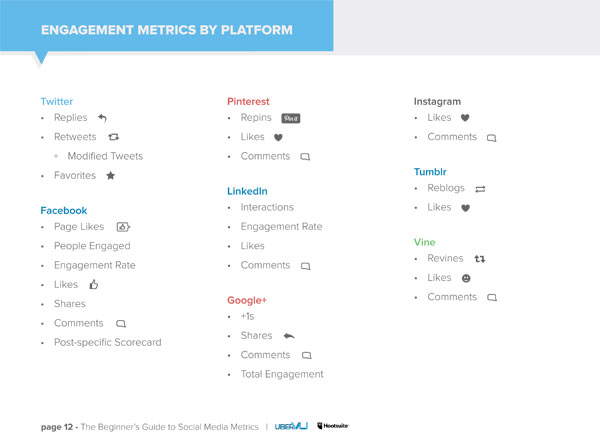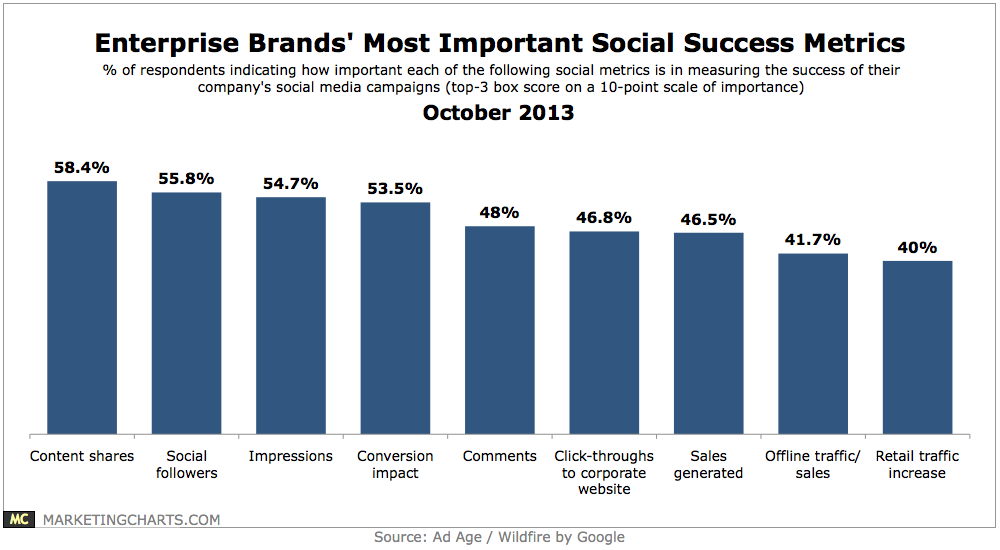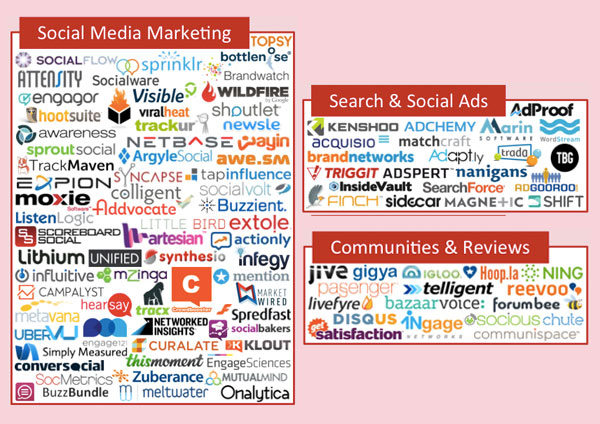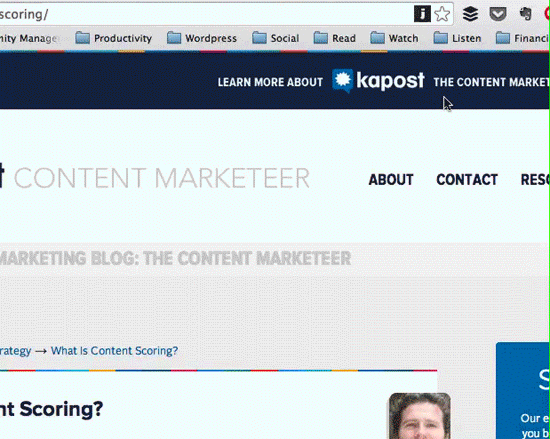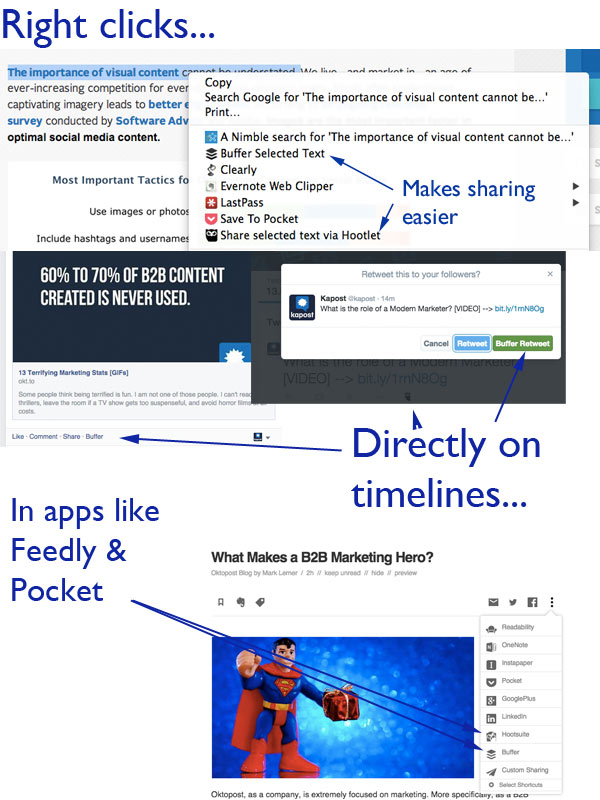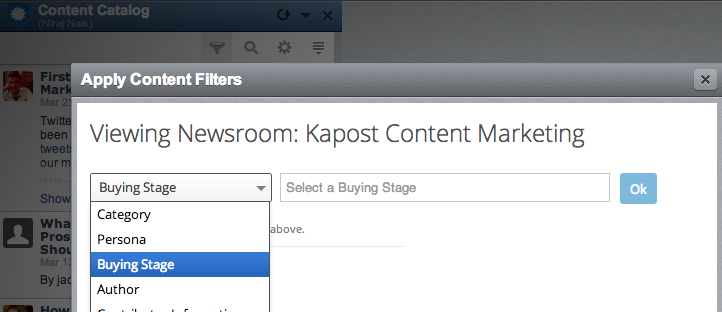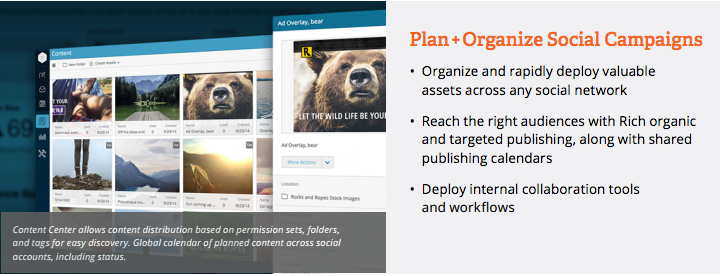Social media can be a dizzying and mystifying experience for businesses large and small. Social media strategies must be restructured often for brands to remain engaging and effective. This means living in a state of constant renewal, which seems like a daunting task.
But it doesn’t have to be. With the right structure in place, it can actually become a sustainable practice.
This two-part guide will walk through major areas of focus for social media teams, how to set up those areas for success, and how to remain flexible and adaptable within a structured operation.
Written by Kapost’s Senior Community & Content Manager, Andrew J. Coate, this guide features plenty of data, charts, and actionable steps with a healthy dose of snark throughout. Enjoy.
Part One: Setting Goals and Choosing Tools
Introduction
I rarely write about social media.
It never seemed useful, because whatever I wanted to say might not be relevant a few months—or even a few weeks—later. I saw social media as a progressive, evolutionary thing, changing faster than I could express fully formed ideas about it.
I still believe this—and due to this same fast-paced and ever-changing state, marketers struggle to “master” social for business. It’s also why we see article after article trying to defend the notion that we can measure social ROI. It’s not easy.
So why am I writing about social media now?
Somewhere along the line, I became “our social guy,” someone who figured out how to keep up with the shifts, who not only educated others on what they “should do” for social business, but who actually took hold of the reins and the responsibility to make numbers go up, get leads in the door, and breathe life into formerly stale or even sputtering social efforts.
My employer, Kapost, values sharing how we do things, how we’ve succeeded and how we’ve failed.
And now it’s my turn.
This guide explains how social media can drive success for your business, and how to make those all-important numbers go up. These tips, tricks, and processes scale up from one-person social teams to large enterprise operations.
But first, let’s start with what’s happening in social media these days.
The State of Things
The days of social media as an afterthought are waning.
The 2014 State of Enterprise Social Marketing Report found that 98% of enterprise companies market on at least one major social network and 58% have plans to use a social network that wasn’t utilized in 2013. Beyond that, 69% of large companies are increasing staffing for social marketing, and social budget is increasing at a greater rate than total worldwide marketing budget. The majority of large companies have an established process to deliver relevant content (74%) and timely content (67%) across social networks.
 The focus on social is here. Yet, many still struggle to produce intended results.
The focus on social is here. Yet, many still struggle to produce intended results.
Only 62% of those surveyed said their organization has a process in place to track conversions/sentiment, and only 59% think there are definite ways to measure business value from social. These findings echo content marketing research, too, which shows 83% of marketers say creating buyer-centric content is a priority, but only 23% claim to be at advanced state of this transition.
Content—including content for social—is created without focus and without any way to gain detailed insights into those efforts. It’s random.
So how does this get better? Improving social marketing’s impact on business means integrating it with broader marketing efforts.
With content now at the center of digital marketing, marketers must organize social around content rather than channels.
For some, this may be a major shift in thought and action. No matter the size and scale of social teams, a strong social operation is built on a foundation of focused goals, purposeful technology, and, of course, solid content.
A strong social operation is built on focused goals, purposeful technology, and solid content.
Rebekah Iliff, Chief Strategy Officer for AirPR adds, “Much like its first cousin, PR, social has shifted from a function within the marketing department to more of a layer within an organization. In other words, social is not just about external communications and reaching the customer; it’s about empowering individuals…to take part in [a] larger conversation.”
There are four key elements to building this cohesive social marketing strategy, and each one will be covered in this two-part guide.
Part One covers goal setting and tool selection. Let’s dive in.
Setting Goals for Social
Yep. I know. I’m kicking off with the boring stuff, the stuff nobody wants to think about.
Early in my career, I cringed whenever I had to fill out questionnaires that asked, “what are your goals?” or “what do you hope to achieve?” or any variation of “how will you be held accountable?”
The problem? It wasn’t always clearly communicated what I was supposed to be working toward. Many social media managers and community managers are hired and tasked with vague mandates such as “grow our follower base” or “boost engagement” or “build a community.” Those things are perfectly acceptable, but they need more clarity and structure.
Easier said than done, right? Right. So here’s how to define your social media goals.
Audit Current Efforts
This isn’t newbie stuff. Sure, I’ve had the good fortune (and also misfortune) of writing a company’s first tweet, or posting their first pseudo-artsy Instagram pic. But if you look at the numbers above, the reality is that most companies are doing something. I’ve learned that regardless of whether a company has tweeted 10 times or operates 10 global accounts 24/7, vital insights can be gleaned from reviewing past tactics and performance.
Here’s how you can look at this data, something I do quarterly:
The social accounts and related processes and workflows may not be new, but they are new to this exact team at this exact time. As mentioned above, things change—even in slow-moving industries. There are new topics of importance and new people constantly entering and exiting a company’s realm of influence. Look back to help you define what to do moving forward.
Once you understand what your company has been doing, determine what your measure of success is—or should be.
Determine the Purpose of Social
Look at your business goals, then see how social fits into the big picture. That’ll determine the direction of your social media and content strategy.
When I began at Kapost, one exec wanted social to be a regular traffic-driver to our content. Another exec wanted that, plus some personality. A third exec thought our community size didn’t reflect our actual influence, and wanted to focus on growing to a point where we looked more prominent. They all wanted influencers to interact with our social accounts and for us to become a “go-to” source for great content.
For my first year, my purpose was a combination of those goals:
- Create a specific Kapost voice
- Drive increasing traffic to our websites from social
- Gain a wider (but targeted) audience on social
- Connect with influencers over social
There are plenty of other purposes for social and many different use cases to consider. For example, we also have social accounts dedicated to customer service, but those are not in my purview.
Know why your social exists, and focus on fulfilling that mission.
Treat your use cases as an important part of your social strategy. For some companies, “brand awareness” and creating good will among customers are completely valid reasons to use social. And social increasingly benefits other parts of an organization beyond its traditional home in marketing and communications.
 Quoting Rebekah Iliff again, “Looking at social merely from a quantitative standpoint, as opposed to an opportunity to generate discourse, listen to customers, and ultimately understand your market, is short-sided.” I echo those thoughts: Tracking quantitative results is important, but it isn’t everything.
Quoting Rebekah Iliff again, “Looking at social merely from a quantitative standpoint, as opposed to an opportunity to generate discourse, listen to customers, and ultimately understand your market, is short-sided.” I echo those thoughts: Tracking quantitative results is important, but it isn’t everything.
As Kat Dominguez of Sprinklr put it, “If you only look at social as a way to directly generate revenue, then you shouldn’t be on social.” It doesn’t matter what you’re measuring (brand awareness, engagement, revenue from social, etc.) or whether your audience is B2B or B2C. They’re not that different and the thinking presented here can be applied to any social situation.
What Are Your KPIs?
Part of goal setting is knowing which metrics indicate success. Some metrics are easy to track, while others (such as sentiment) are still elusive. The more sophisticated your social operation and supporting tools, the more detailed and in-depth your reporting becomes.
Almost all operations focus in some part on the larger categories of Brand Mentions, Reach/Exposure, Engagement, Growth, Sentiment, Share of Voice, and Traffic or Lead Generation.
I outlined the following initial metrics to guide my reporting at Kapost:

From an “engagement” perspective, UberVu has a solid starting place in their Guide to Social Metrics:
Even further, a 2013 study by AdAge and Wildfire by Google showed these metrics as a priority among enterprise marketers:
It’s important to note that each social network has its own unique metrics to track. It takes time to learn what data is available (Facebook and Pinterest, for example, constantly adjust their analytics tools) and what to do with it.
Choosing the Right Tools
This part’s a little more fun. We get to geek out about technology, oh, and spend someone else’s money!
In all seriousness, figuring out which software to use to achieve and measure your goals and KPIs can be a pain. I mean, who actually likes researching this stuff, reading product spec sheets, sitting on demo calls, and setting up 30-day trials of various products? Luckily for anyone reading this, I do!
At the risk of annoying my friends and sales reps waiting for me to call them back at various social software companies, I’ll say this—there isn’t one tool to rule them all.
How could there be? There are many distinct use cases that require specific feature sets. The purpose of adopting social media management software is to manage, scale, and measure one or more of the following:
There isn’t one tool to rule them all.
- Publishing/Engagement
- Listening
- Curation
- Promotions
- Social selling
- Analytics
- Customer care
While a few get close, there simply isn’t a golden platform that gives you absolutely everything you need.
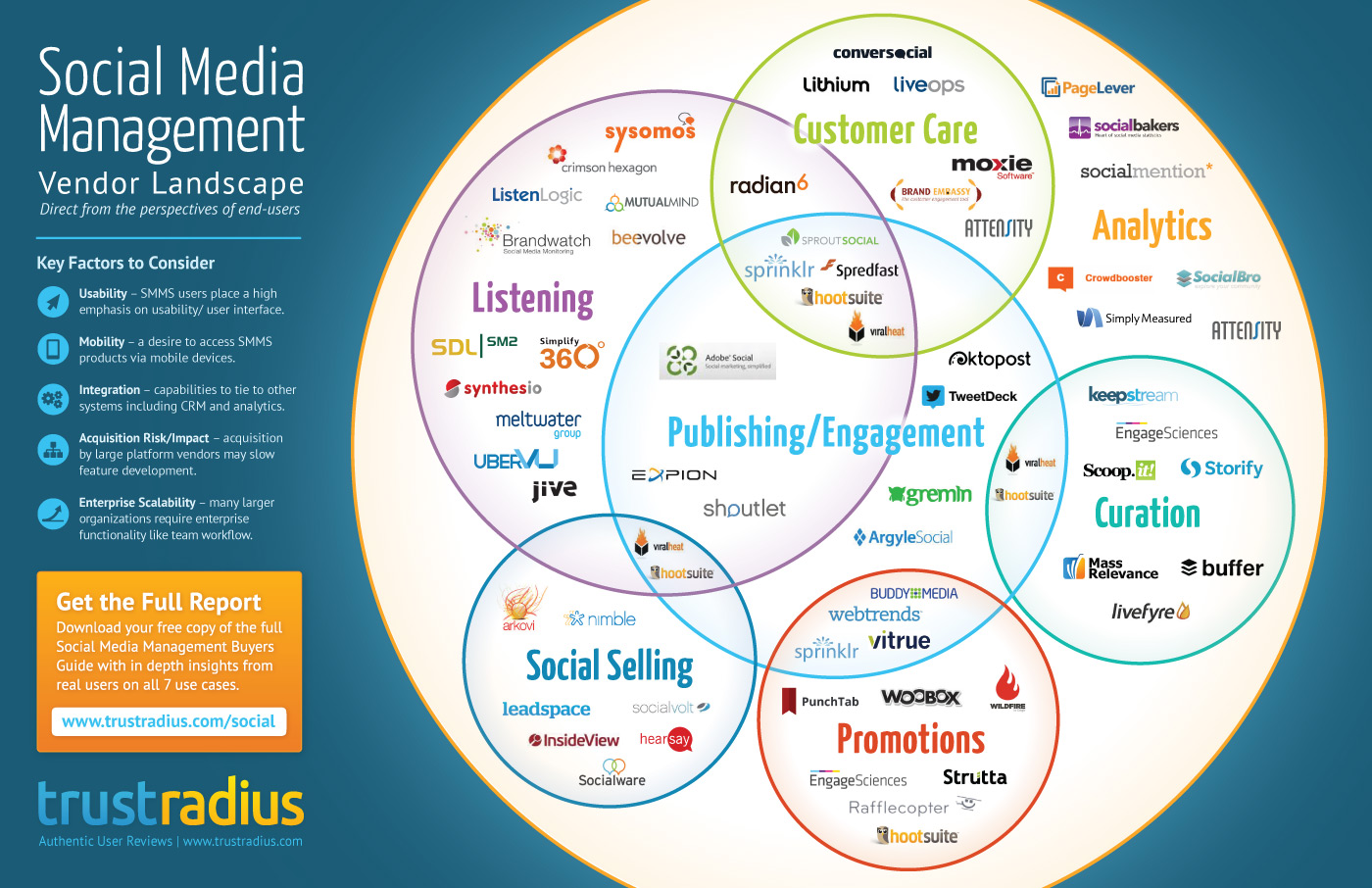
This guide was based upon in-depth user reviews of 36 different products by practitioners at large enterprises like Dell and Hertz to smaller organizations, agencies.
Business software review site TrustRadius provided the graphic above as part of a comprehensive analysis of the enterprise social space. They do a fantastic job not only documenting the landscape of tools and platforms, but breaking down the seven use cases above and advising which features and abilities to look for in a solution.
I’ve found the following functions to be the most valuable in a tool or platform, across various use cases:
- Real-time usability
- Customizable queue
- Editorial calendar
- Content library
Real-Time Usability
Most social platforms have the ability to schedule posts in advance, and often target them to specific sites at specific times, and even to specific demographics when available. That’s great, except for the whole “best laid schemes o’ mice an’ men” thing. What do I mean?
It’s impossible to operate under a “set it and forget it” social strategy.
Social media requires persistent and ongoing attention. Interactions about a brand’s content and products spring up all the time. So do conversations that may be of interest to your company, such as those surrounding important keywords, competitors, or topics trending with a target audience.
With that in mind, your social tool or platform needs to enable quick and easy responses, and have the ability to share content on the fly from wherever you might find it. Most platforms refer to these features as “streams” and some, like Sprout Social, even highlight higher priority opportunities to engage, helping you filter out the noise.
Aside from interacting across profiles without having to bounce back and forth between different platforms, a killer browser extension is among my biggest requirements when reviewing base social platforms.
When installed in your browser of choice, Buffer and Hootsuite’s extensions, for example, go to work adding all sorts of shortcuts to the various places you’re likely to discover content. You can post to connected social sites directly from timelines or apps like Feedly, Pocket, or Flipboard. In addition, right-clicking on an image or highlighted text offers a menu of options.
These features are essential for the timely creation of social posts as well as content curation.
Oktopost has made this process as simple as possible with their browser extension and in-app features. Within the Oktopost dashboard, you can monitor streams of connected social sites including Twitter, Facebook, Google+, Linkedin pages, and LinkedIn groups, and you can interact with those streams without leaving the platform.They also provide content recommendations and connect with Feedly to help pull relevant third party content that a user is likely to share.
Customizable Queue
A recent addition to social distribution platforms is the ability to automatically queue posts to go out throughout the day. This is meant to be not only a time-saver, but to help schedule social posts during the optimal days and hours to increase engagement.
In my experience, this is a work in progress. Every autoscheduling or queue tool seems to have a different algorithm for selecting post times. Autoscheduling cannot fully replace the manual monitoring of which posts are scheduled and when. So I find it important to have manual override or customizable settings when it comes to using autoschedulers.
Buffer and Oktopost, for example, make it easy to adjust when specific posts go live, and also set time ranges for when content can be autoscheduled. These tools generally don’t get it exactly perfect, since “ideal” or “optimal” times can vary.
While there are some great general guidelines to follow here, it’s important to research and understand the social habits of your target audience, schedule posts within a range that is likely to be effective, and audit the timing of those posts—which leads me to the next key feature.
Editorial Calendar
An editorial calendar for your content is an absolute must. An editorial calendar helps organize and visualize marketing initiatives in a single place. A good one goes way beyond simple dates to help sort content pieces by campaign, track who is responsible for creating each piece of content, and organize content around broader marketing themes and topics.
An editorial calendar for your content is an absolute must.
Most enterprise tools have some version of this feature. Sprinklr‘s even allows for any social content to be tagged with a variety of data points, connecting those posts to wider campaigns and themes.
An editorial calendar serves as a central place where each contributor, stakeholder, and project manager can access the information necessary to stay on top of the progress of content pieces or entire campaigns, or can plan ahead for upcoming initiatives and the publication of new content.
This type of visibility is essential to ensure all content is receiving appropriate social support, and also to avoid either incomplete or overlapping efforts. Marketo has a fantastic post and template to help further understand the value of an editorial calendar in a social context.
Content Library
I’m a big believer in content reuse, especially when it comes to social media. I try the same post multiple times across multiple days, and I like to give old posts new life. This gives me a wider data set when reviewing the effectiveness of various posts. As such, it’s been essential for me to have a place where I can easily locate and sort through social posts and reshare if I decide to.
A content library also allows internal stakeholders to stay up to date on content production efforts. The Kapost library allows all members of a company to access and sort completed content based on a variety of factors including content type, theme, or targeted persona. Users can then share that content with their audiences. Kapost’s integration with Hootsuite makes sharing even more powerful, as social teams can have that library show up in their Hootsuite dashboard.
Spredfast has a similar feature that enables teams to sort by content approved for particular purposes and share from there.
A content library is a must-have for growing organizations. It ensures the right content is available at the right time for the right audiences. It enables not only control over what gets shared, but ease of reusing and auditing that content on a regular basis.
While the above features are critical to a strong social platform, remember that the platform must always support your goals. As Kapost’s Liz O’Neill Dennison puts it, “Identify your content and process needs first. Compare technology vendors second.”
This concludes Part One. Part Two will cover content distribution strategies and tactics, as well as an in-depth look at reporting.



